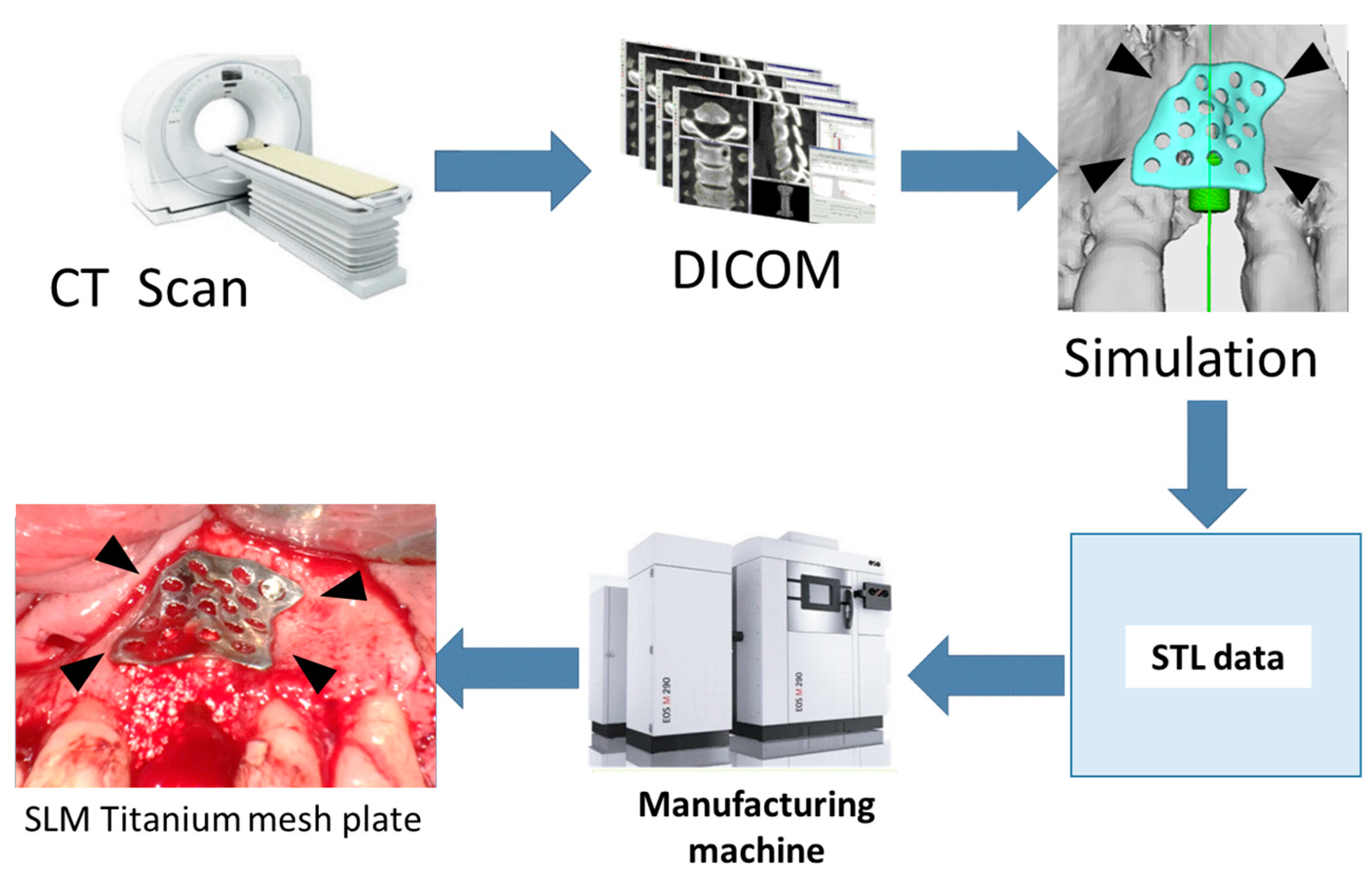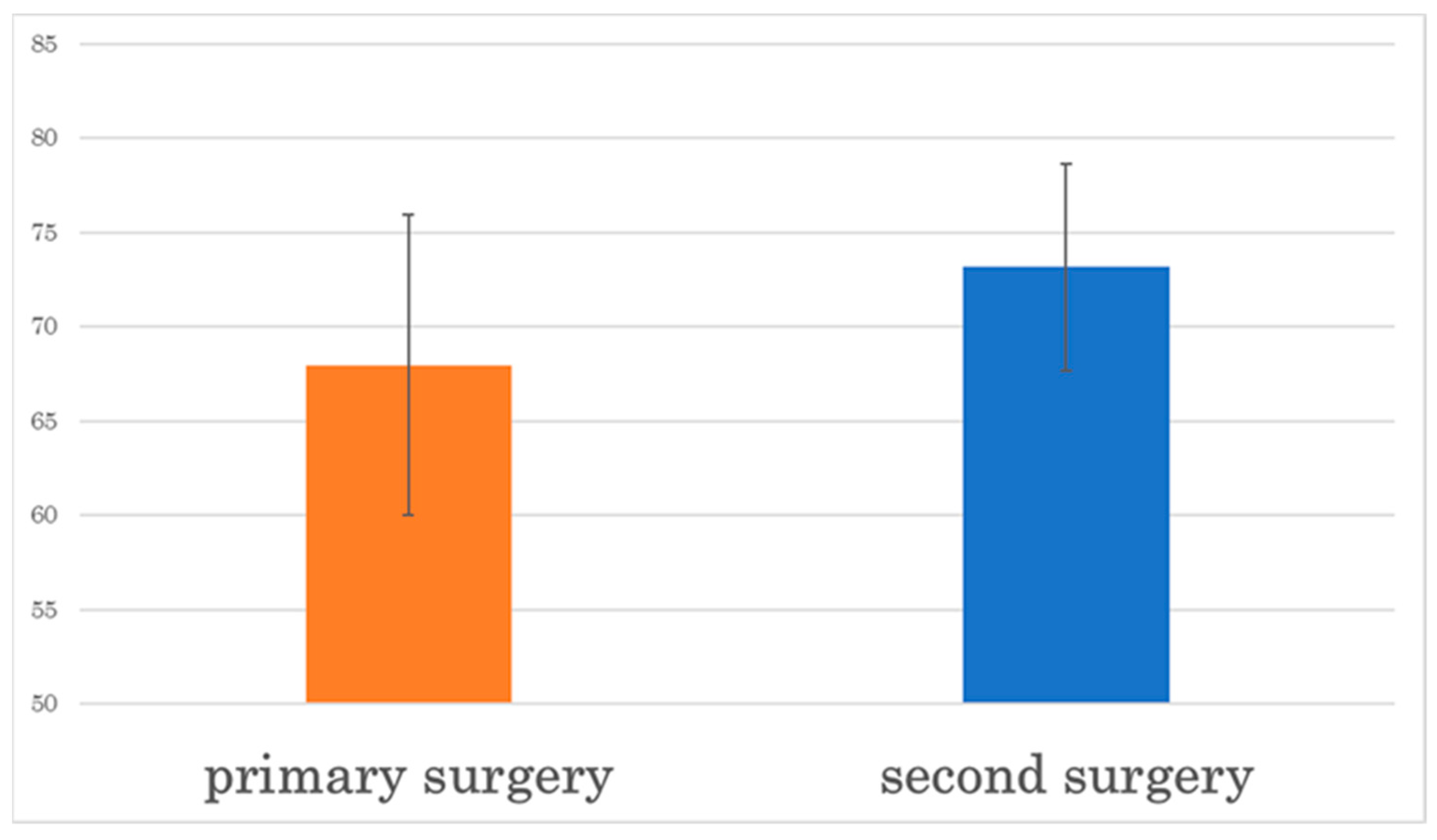Clinical Study of 14 Cases of Bone Augmentation with Selective Laser Melting Titanium Mesh Plates
Abstract
1. Introduction
2. Materials and Methods
2.1. Patients
2.2. Fabricate SLM Titanium Mesh
2.3. Evaluation Item
2.4. Case Presentation
3. Results
- (1)
- Number of screws used for fixation
- (2)
- Mesh exposure and infection
- (3)
- Simultaneous implant placement
- (4)
- ISQ value
- (5)
- Hard tissue occupancy of the bone augmentation area
- (6)
- Bone resorption rate
4. Discussion
5. Conclusions
Author Contributions
Funding
Institutional Review Board Statement
Informed Consent Statement
Conflicts of Interest
References
- McAllister, B.S.; Haghighat, K. Bone Augmentation techniques. J. Periodontol. 2007, 78, 377–396. [Google Scholar] [CrossRef] [PubMed]
- Vinay, V.K.; Supriya, E.; Andreas, T. Bone Augmentation Procedures in Implantology. In Oral and Maxillofacial Surgery for the Clinician; Springer: Singapore, 2021; pp. 407–426. [Google Scholar]
- Giuseppe, L.; Gerardo, P.; Gliuseppe, C.; Agnese, F.; Claudio, M.; Pietro, F. Guided bone regeneration using titanium mesh to augment 3-dimensional alveolar defects prior to implant placement. A pilot study. Clin. Oral Implant. Res. 2022, 33, 607–621. [Google Scholar]
- Inoue, K.; Nakajima, Y.; Omori, M.; Kato-Kogoe, N.; Yamamoto, K.; Kitagaki, H.; Mori, H.; Nakano, H.; Ueno, T. Reconstruc-tion of the alveolar bone using bone augmentation with selective laser melting titanium mesh sheet: A report of 2 cases. Implant. Dent. 2018, 27, 602–607. [Google Scholar] [CrossRef] [PubMed]
- Marco, T.; Chang-Joo, P.; Aurea, L.L.; Marco, A.; Edoardo, B.; Alba, K.; Silvio, M.M. Customized 3D-Printed Titanium Mesh Developed to Regenerate a Complex Bone Defect in the Aesthetic Zone: A Case Report Approached with a Fully Digital Workflow. Materials 2020, 13, 3874. [Google Scholar]
- Balleri, P.; Cozzolino, A.; Ghelli, L.; Momicchioli, G.; Varriale, A. Stability measurements of osseointegrated implants using Osstell in partially edentulous jaws after 1 year of loading: A pilot study. Clin. Implant. Dent. Relat. Res. 2002, 4, 128–132. [Google Scholar] [CrossRef]
- Ostman, P.O.; Hellman, M.; Wendelhag, I.; Sennerby, L. Resonance frequency analysis measurements of implants at placement surgery. Int. J. Prosthodont. 2006, 19, 77–83. [Google Scholar]
- Matsumoto, K.; Mano, T.; Inoue, K.; Yamamoto, K.; Imagawa-Fujimura, N.; Takahashi, A.; Ueno, T. Investigation of implant stability quotient values of dental implants placed in vascularized bone grafts. J. Hard Tissue Biol. 2022, 31, 55–58. [Google Scholar] [CrossRef]
- Yamamoto, K.; Yamaguchi, S.; Matsushita, T.; Mori, S.; Kitagaki, H.; Yoshimura, H.; Sano, K.; Sunano, A.; Nakkajima, Y.; Nakano, H.; et al. Histologic evaluation of bone regeneration using titanium mesh prepared by selective laser melting technique. J. Hard Tissue Biol. 2017, 26, 257–260. [Google Scholar] [CrossRef][Green Version]
- Chiapasco, M.; Casentini, P.; Zanniboni, M. Bone augmentation procedures in implant dentistry. Int. J. Oral Maxillofac. Implant. 2009, 24, 237–259. [Google Scholar]
- Yu, X.; Songhang, L.; Tianxu, Z.; Chao, W.; Xiaoxiao, C. Titanium mesh for bone augmentation in oral implantology: Current application and progress. Int. J. Oral Sci. 2020, 12, 37. [Google Scholar]
- Jung, G.U.; Jeon, J.Y.; Hwang, K.G.; Park, C.J. Preliminary evaluation of a three-dimensional, customized, and preformed titanium mesh in peri-implant alveolar bone regeneration. J. Korean Assoc. Oral Maxillofac. Surg. 2014, 40, 181–187. [Google Scholar]
- Terheyden, H.; Meijer, G.; Raghoebar, G. Vertical bone augmentation and regular implants versus short implants in the vertically deficient posterior mandible: A systematic review and meta-analysis of randomized studies. Int. J. Oral Maxillofac. Surg. 2021, 50, 1249–1258. [Google Scholar] [CrossRef] [PubMed]
- Jeong, K.I.; Kim, Y.K.; Moon, S.W.; Kim, S.G.; Lim, S.C.; Yun, P.Y. Histologic analysis of resorbable blasting media sur-face implant retrieved from humans: A report of two cases. J. Korean Assoc. Oral Maxillofac. Surg. 2016, 42, 38–42. [Google Scholar] [CrossRef] [PubMed]
- Alhomsi, M. Implications of titanium surface modifications on dental implants. EC Dent. Sci. 2018, 17, 2064–2072. [Google Scholar]
- Alessandro, C.; Elisabetta, V.; Aldo, N.; Claudio, M.; Giuseppe, C. The influence of wound closure on graft stability: An in vitro comparison of different bone grafting techniques for the treatment of one-wall horizontal bone defects. Clin. Implant. Dent. Relat. Res. 2017, 19, 821–832. [Google Scholar]
- Sumida, T.; Otawa, N.; Kamata, Y.U.; Kamakura, S.; Matsushita, T.; Kitagaki, H.; Mori, S.; Sasaki, K.; Funabayashi, S.; Takemoto, M.; et al. Custom-made titanium devices as membranes for bone augmentation in implant treatment: Clinical application and the comparison with conventional titanium mesh. J. Cranio-Maxillofac. Surg. 2015, 43, 2183–2188. [Google Scholar] [CrossRef]
- Vianna, T.; Taiete, T.; Casarin, R.; Giorgi, M.; Aguiar, F.; Silvério, K.; Nociti, J.; Sallum, E.; Casati, M. Evaluation of pe-ri-implant marginal tissues around tissue level and bone level implants in patients with a history of chronic perio-dontitis. J. Clin. Periodontol. 2018, 45, 1255–1265. [Google Scholar] [CrossRef]
- Wysocki, B.; Idaszek, J.; Zdunek, J.; Rożniatowski, K.; Pisarek, M.; Yamamoto, A. The influence of selective laser melt-ing (slm) process parameters on in-vitro cell response. Int. J. Mol. Sci. 2018, 19, 1619. [Google Scholar] [CrossRef]
- Otawa, N.; Sumida, T.; Kitagaki, H.; Sasaki, K.; Fujibayashi, S.; Takemoto, M.; Nakamura, T.; Yamada, T.; Mori, Y.; Matsushita, T. Custom-made titanium devices as membranes for bone augmentation in implant treatment: Modeling accuracy of titanium products constructed with selective laser melting. J. Cranio-Maxillofac. Surg. 2015, 43, 1289–1295. [Google Scholar] [CrossRef]
- Kim, K.B.; Kim, J.H.; Kim, W.C.; Kim, H.Y.; Kim, J.H. Evaluation of the marginal and internal gap of metal-ceramic crown fabricated with a selective laser sintering technology: Two- and three- dimensional replica techniques. J. Adv. Prosthodont. 2013, 5, 179–186. [Google Scholar] [CrossRef]
- Örtorp, A.; Jönsson, D.; Mouhsen, A.; Steyernet, P.V.V. The fit of cobalt–chromium three-unit fixed dental prostheses fabricated with four different techniques: A comparative in vitro study. Dent. Mater. 2011, 27, 356–363. [Google Scholar] [CrossRef] [PubMed]



| Case | Sex | Age | Missing Teeth | Screw | Implants | Bone Occupacy | Bone Resorption |
|---|---|---|---|---|---|---|---|
| 1 | F | 82 | 43, 44 | 1 | 2 | 89.2 | 0.51 |
| 2 | F | 63 | 35, 36 | 1 | 2 | 84.8 | 0.33 |
| 3 | M | 73 | 45, 46 | 1 | 2 | 92.1 | 0.73 |
| 35, 35 | 1 | 2 | 85.0 | 1.11 | |||
| 4 | M | 72 | 24, 25, 26, 27 | 1 | 3 | 87.0 | 1.12 |
| 5 | F | 56 | 21 | 1 | 1 | 88.0 | 0.93 |
| 6 | F | 71 | 11 | 1 | 1 | 92.0 | 0.87 |
| 7 | M | 45 | 22 | 1 | 1 | 96.7 | 0.52 |
| 8 | M | 55 | 11, 12, 13, 14 | 2 | 3 | 89.0 | 0.53 |
| 9 | M | 61 | 12 | 1 | 1 | 92.0 | 0.33 |
| 10 | F | 64 | 21, 23 | 1 | 1 | 93.0 | 0.35 |
| 11 | M | 55 | 14, 15 | 2 | 2 | 85.2 | 0.76 |
| 12 | M | 53 | 11, 12 | 1 | 2 | 83.0 | 0.65 |
| 13 | F | 72 | 25 | 1 | 1 | 87.0 | 0.96 |
| 14 | M | 46 | 11 | 1 | 1 | 83.3 | 0.68 |
Disclaimer/Publisher’s Note: The statements, opinions and data contained in all publications are solely those of the individual author(s) and contributor(s) and not of MDPI and/or the editor(s). MDPI and/or the editor(s) disclaim responsibility for any injury to people or property resulting from any ideas, methods, instructions or products referred to in the content. |
© 2023 by the authors. Licensee MDPI, Basel, Switzerland. This article is an open access article distributed under the terms and conditions of the Creative Commons Attribution (CC BY) license (https://creativecommons.org/licenses/by/4.0/).
Share and Cite
Takahashi, A.; Inoue, K.; Imagawa-Fujimura, N.; Matsumoto, K.; Yamada, K.; Sawai, Y.; Nakajima, Y.; Mano, T.; Kato-Kogoe, N.; Ueno, T. Clinical Study of 14 Cases of Bone Augmentation with Selective Laser Melting Titanium Mesh Plates. Materials 2023, 16, 6842. https://doi.org/10.3390/ma16216842
Takahashi A, Inoue K, Imagawa-Fujimura N, Matsumoto K, Yamada K, Sawai Y, Nakajima Y, Mano T, Kato-Kogoe N, Ueno T. Clinical Study of 14 Cases of Bone Augmentation with Selective Laser Melting Titanium Mesh Plates. Materials. 2023; 16(21):6842. https://doi.org/10.3390/ma16216842
Chicago/Turabian StyleTakahashi, Ayaka, Kazuya Inoue, Naoko Imagawa-Fujimura, Keisuke Matsumoto, Kazuto Yamada, Yasuhisa Sawai, Yoichiro Nakajima, Takamitsu Mano, Nahoko Kato-Kogoe, and Takaaki Ueno. 2023. "Clinical Study of 14 Cases of Bone Augmentation with Selective Laser Melting Titanium Mesh Plates" Materials 16, no. 21: 6842. https://doi.org/10.3390/ma16216842
APA StyleTakahashi, A., Inoue, K., Imagawa-Fujimura, N., Matsumoto, K., Yamada, K., Sawai, Y., Nakajima, Y., Mano, T., Kato-Kogoe, N., & Ueno, T. (2023). Clinical Study of 14 Cases of Bone Augmentation with Selective Laser Melting Titanium Mesh Plates. Materials, 16(21), 6842. https://doi.org/10.3390/ma16216842






